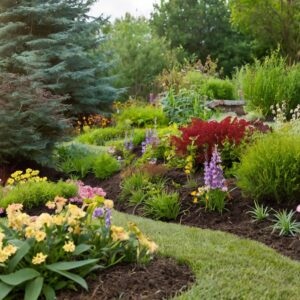
Berms, the elevated mounds of soil often used in landscaping, serve various purposes from erosion control to creating visual interest in an otherwise flat terrain. However, the challenge lies in selecting the right plants and employing suitable planting techniques to ensure these elevated gardens flourish. Through investigative research and expert consultations, we unveil the best practices for selecting and planting grasses, shrubs, and perennials on berms, along with ideas for crafting visually captivating plant arrangements.
Selecting Suitable Plants for Berms
The unique structure of berms demands plants that can adapt to well-draining soil and varying moisture levels. Here, we delve into the best plant options across different categories.
Grasses
1. Feather Reed Grass (Calamagrostis x acutiflora ‘Karl Foerster’): This ornamental grass is praised for its upright form and tolerance to a wide range of soil conditions. Its golden plumes add a touch of elegance from summer through winter.
2. Blue Fescue (Festuca glauca): Known for its striking blue-gray foliage, Blue Fescue is a compact grass that thrives in well-drained soil and can handle drought conditions once established.
3. Switchgrass (Panicum virgatum): A native prairie grass, Switchgrass is highly adaptable and resilient, making it an excellent choice for berms. It also provides visual interest with its airy, cloud-like seed heads.
Shrubs
1. Dwarf Korean Lilac (Syringa meyeri ‘Palibin’): This compact shrub is perfect for adding a splash of color and fragrance in late spring. It’s drought-tolerant and thrives in full sun to partial shade.
2. Potentilla (Potentilla fruticosa): A hardy shrub with a long blooming period, Potentilla offers bright yellow flowers and thrives in well-drained soil. It’s an excellent choice for adding color and texture to berms.
3. Creeping Juniper (Juniperus horizontalis): This low-growing evergreen shrub provides excellent ground cover and erosion control. Its spreading habit makes it ideal for the slopes of a berm.
Perennials
1. Coneflower (Echinacea purpurea): Renowned for its drought tolerance and long-lasting blooms, Coneflower adds vibrant color and attracts pollinators. It thrives in full sun and well-drained soil.
2. Daylily (Hemerocallis): Daylilies are low-maintenance perennials with a wide range of colors. They are adaptable to various soil conditions and provide continuous blooms throughout the summer.
3. Black-eyed Susan (Rudbeckia hirta): This cheerful perennial is tough and resilient, thriving in poor soils and full sun. Its bright yellow flowers create a striking contrast against green foliage.
Planting Techniques Specific to Berms
The success of berm plantings largely hinges on proper soil preparation and planting techniques. Through extensive research and expert advice, we outline the best practices to follow.
Soil Composition
1. Well-Draining Soil: Berms require soil that drains well to prevent waterlogging at the base. A mix of sandy soil and organic matter, such as compost, ensures adequate drainage while retaining some moisture.
2. Soil Amendments: Adding organic matter improves soil structure and fertility. Incorporate compost, aged manure, or peat moss into the berm to enhance its ability to support plant growth.
3. Soil Testing: Before planting, conduct a soil test to determine pH and nutrient levels. Most plants prefer slightly acidic to neutral soil (pH 6.0-7.0). Adjust soil pH with lime or sulfur as needed.
Planting Techniques
1. Layering the Berm: When constructing the berm, layer the soil to create a gradient. Place coarser materials like gravel or sand at the bottom for drainage, followed by the topsoil and organic matter mix.
2. Planting Depth: Ensure plants are placed at the same depth they were growing in their containers. Planting too deep or too shallow can stress the plants and hinder growth.
3. Watering Strategy: Newly planted berms need consistent moisture until the plants establish. Use drip irrigation or soaker hoses to deliver water directly to the root zone, reducing runoff and evaporation.
4. Mulching: Apply a layer of mulch around plants to conserve moisture, suppress weeds, and regulate soil temperature. Organic mulches like wood chips or shredded bark are effective choices.
Creating Visually Appealing Plant Arrangements
A well-designed berm can transform a landscape with its dynamic, eye-catching appeal. Here are some strategies for arranging plants to achieve a harmonious and aesthetically pleasing display.
Layering and Height Variation
1. Vertical Interest: Use a mix of tall, medium, and low-growing plants to create layers. Place taller plants like Feather Reed Grass or Switchgrass at the top or back of the berm, with shorter perennials like Blue Fescue and Daylilies in the foreground.
2. Naturalistic Planting: Mimic nature by clustering plants in irregular groups rather than straight lines. This approach creates a more organic and fluid appearance.
3. Seasonal Interest: Choose plants that offer visual appeal across different seasons. For instance, combine spring-blooming shrubs like Dwarf Korean Lilac with summer perennials such as Coneflowers and fall-interest grasses like Switchgrass.
Color and Texture
1. Complementary Colors: Use the color wheel to select complementary colors that enhance each other. For example, pair the purple blooms of Coneflowers with the yellow flowers of Black-eyed Susans for a vibrant contrast.
2. Textural Contrast: Combine plants with varying textures to add depth and interest. The fine, airy texture of Switchgrass contrasts beautifully with the broad, bold leaves of Daylilies.
3. Focal Points: Incorporate focal points like a striking shrub or a large ornamental grass to draw the eye and anchor the design. Potentilla or Creeping Juniper can serve as effective focal points.
Sustainability and Maintenance
1. Native Plants: Opt for native plants whenever possible, as they are better adapted to local conditions and require less maintenance. Native plants also support local wildlife and pollinators.
2. Low-Maintenance Choices: Select drought-tolerant and disease-resistant plants to reduce the need for watering, fertilizing, and pest control. Perennials like Coneflowers and Black-eyed Susans are excellent low-maintenance options.
3. Continuous Bloom: To ensure continuous visual interest, choose a mix of plants with staggered blooming periods. This approach provides a dynamic and ever-changing display throughout the growing season.

1 thought on “Top 10 Plants and Tips for Beautiful Berms”